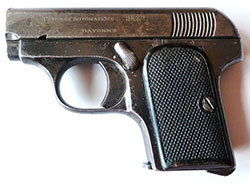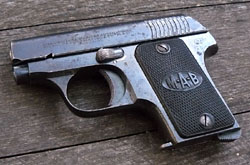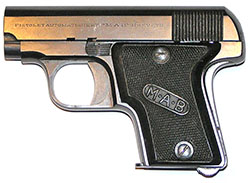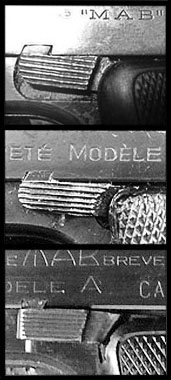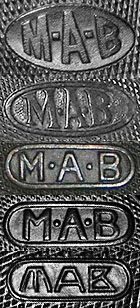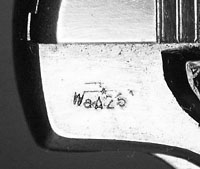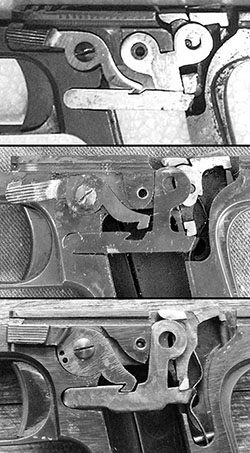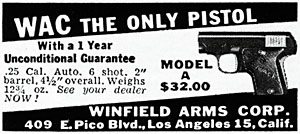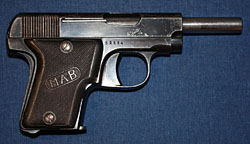 |
||||||||||||||||||||||||||||||||||||||||||||||||||||||||||||||||||||||||||||||||||||||||||||||||||||||||||||||||||||||||||||||||||||||||||||||||||||||||||||||||||||||||||||||||||||||||||||||||||||||||||||||||||||||||||||||||||||||||||||||||||||||||||||||||||||||||||||||||||||||||||||||||||||||||||||||||||||
|
The MAB Model A by Ed Buffaloe
The Type I MAB Model A, in one form or another, was produced from sometime before World War I until 1924. The gun is essentially a 6.35mm Eibar-type pistol of the sort which were manufactured in large quantities in the Basque region of Northern Spain and Southern France in the first three decades of the 20th century. Most, including the MAB, had the manual safety moved forward of the grip, and the grip safety eliminated to simplify production. These Type I pistols, according to Bastié & Casanova in their book Les Pistolets MAB, were made by Gregorio Bolumburu of Eibar, Spain, and had the following slide inscription on the left-hand side:
or PISTOLET AUTOMATIQUE “REX” or PISTOLET AUTOMATIQUE “REX” No 2
According to Bastié & Casanova, in 1920 Léon Barthe formed the Manufacture d’Armes Automatiques, which shortly thereafter was renamed to Manufacture d’Armes de Bayonne, so it must be about this time that the following slide inscription appeared: MANUFACTURE D'ARMES AUTOMATIQUES and later: PISTOLET AUTOMATIQUE CAL. 635 This final inscription states specifically that the gun is made in France, and of course the previous inscriptions said Bayonne. Perhaps they were made in Eibar, as asserted by Bastié & Casanova. However, a collector who specializes in Spanish pistols asserts that he has never seen a pistol made by Gregorio Bolumburu that was not marked “GB” somewhere on the gun, so he believes that the early REX and other pistols marked “MAB” were made in France by Léon Barthe or his Basque gunsmith employees. Huon, in his book Les Pistolets Automatiques Francais: 1890-1990, states that the MAB Type I Model A is based on the 1906 FN Browning but, while it is true that the early MAB is externally similar to the 1906 Browning and about the same size, it has an internal hammer and so is more like the 1903 Colt. The Type I Model A features a rotating manual safety above the trigger. The safety does not lock the slide when engaged. However if the safety is engaged when the slide is retracted it will lock the slide open in the correct position for takedown. The gun features a captive recoil spring, and some variants also have a magazine safety. We do not know whether the magazine safety was a late innovation, or if it was in the early models and was later eliminated--we do know that serial numbers 327 and 511 have the magazine safety, whereas serial numbers 26 and 871 do not. (Please contact us if you have a Type I and let us know your serial number and whether or not your gun has the magazine safety.) There is no grip safety. The slide has ten curved serrations at the rear. The grip plates are of checkered horn, with an oval-shaped M-A-B monogram in the center. The letters “MAB” are also stamped in an oval on the left side of the grip tang. The serial number is stamped on the grip frame on left side beneath the grip plate. The Model A has a fixed barrel with the recoil spring located beneath it. There is a sighting groove on top of the slide. Huon gives the length of the gun as 113mm, and the length of the barrel as 54mm. It weighs 350 grams (12.4 ounces), and holds six rounds in the magazine. These early Model A guns are quite scarce. Probably less than 10,000 were made. I should point out that the gun was not known as the Model A at the time of its introduction. It was simply the “Pistolet Automatique MAB.” The model designation did not become necessary until later. And it may be that this early pistol was never referred to as the Model A by anyone involved with MAB. Type II Model A
Huon gives the length of the Type II as 118mm, but I measure it at 113mm--the same as Huon gives for the Type I. The slide has 16 vertical, triangular-cut serrations. There was still no model designation when the Type II first appeared. The gun continued to be known as the “Pistolet Automatique MAB.” The serial number is located on the right side of the frame, just above the trigger. The first serial number for a Type II was 10001. According to Huon (and Josserand) production of the Model A ceased in September of 1964. In Pistols of the World Hogg & Walter state that manufacture ended in 1985, but we find little evidence to support this. It is clear that the design of the MAB Model A evolved over time. We have distinguished at least three distinct variants, though there may be more. Additionally, until we examine more guns we cannot be certain that all changes in the variants illustrated were applied at once. Changes may have been incremental, and there may be guns with features intermediate between those of the variants shown here. | The first variant, like the Spanish Eibar pistols, shows some simplification of the original Browning design, such as the elimination of the stirrup-shaped connector bar between the trigger and the sear, which ran on both sides of the magazine well. Along with the grip safety, this was probably the first thing to go in the early Spanish copies, because it was too complicated and time-consuming to manufacture. The stirrup was replaced by a simple steel bar between the trigger and the sear that ran on one side of the frame. Browning’s disconnector was a projection from the top of the stirrup-shaped connector, which was pressed down by the recoiling slide, disconnecting the connector and sear. This design was replaced on most Spanish Eibar pistiols by a vertical bar of metal that was pushed down by the slide as it recoiled to the rear--it depressed the connector bar so it could not engage the sear again until the slide returned to its forward position. But the Type II MAB Model A diverged from the Eibar pistols. The early MAB disconnector features two round lobes on top, reminiscent of cartoon mouse ears. The forward lobe pivots on a round axle milled into the frame, while the rear lobe is depressed by the slide as it recoils, disengaging the connector bar. We have examined a lot of automatic pistols, but this design is unique in our experience. The Model A trigger is milled from sheet steel. Browning’s trigger pivots on a pin through the frame, whereas the Model A has a sliding trigger. Browning’s manual safety is located at the rear of the frame and locks the sear, whereas the Model A has a pivoting lever just above and behind the trigger which locks the connector bar. (The Spanish Eibar pistols have a pivoting safety above and behind the trigger which locks the trigger.)
The manual safety lever on the first variant Type II is flat, and fits into a recess milled into the frame, such that there is just room for the safety to move up or down a millimeter or two. On the back side of the lever is a recessed ball bearing that mates with two depressions in the frame to provide click stops for the On and Off positions of the safety. The lower portion of the frame recess serves as a positive stop for the safety in the Off position. Another unique feature on the first variant of the Type II Model A is the design of the firing pin spring guide, which has a small pin projecting at a right angle from its rear section. This pin locks into a recess in the top of the slide and prevents the striker and spring from flying out when the slide is removed from the frame. The rear section of the guide has a slot in back, which can be used to turn it into position with a small screwdriver. The slot is vertical when the spring guide is locked in place, and is held in this position by a vertical bar of metal in front of the backstop for the firing pin spring, so the guide cannot be turned out of its locked position while the slide is on the frame. The upper portion of the grip safety lever is the width of the inner compartment of the frame. Like the Browning, the grip safety on the Model A securely blocks the
sear, making the gun safe to carry with a round in the chamber. Magazines for the early variant had five staggered holes drilled in each side to allow the cartridges to be visible. The base was pinned to the magazine body. Some had the letters “MAB” stamped in an oval on the side of the magazine, and some had “MAB” stamped on the base. We have been unable to determine which is the earlier configuration. The grips are of checkered horn, and are perfectly flat on the back. They have a wide smooth border, and feature the serif letters “M•A•B” with dots between them in an elongated oval. The slide legend on the first variant Type II Model A (observed in serial numbers 10449-97973) was in serif characters on a single line, as follows: PISTOLET AUTOMATIQUE 635 “MAB” BREVETÉ The word “breveté” means “patentee,” or as an adjective “patented or certificated.” In the context here, it means that the pistol has been patented.
The shape of the lower projection of the sear that engages the connector bar was modified slightly. The connector bar and disconnector became a single unit, the pivoting front lobe of the disconnector being eliminated. The milled portion of the frame beneath the manual safety latch was reduced so that most of its area was covered by the grip plate. The latch itself was modified so that it was no longer flat, but the portion grasped by the thumb bent up slightly out of the milled area to clear the surface of the frame. The pin that held the firing pin spring guide in place was eliminated. The vertical bar on the firing pin spring backstop was eliminated and the backstop was slightly enlarged, with an inset to fit the back of the firing pin spring guide. The trigger was reduced in size so it did not protrude as far into the trigger guard. We believe it likely that the grip monogram was also changed at this time. The characters became more stylized and the dots between the letters were
eliminated. The “MAB” stamped on the left side of the slide also used the stylized sans-serif characters. The grip plates had a more narrow smooth
area surrounding the checkering, and the back of the plates remained flat. We are not entirely certain what the grip plates were made from during this period, though many of
them are known for disintegrating easily. PISTOLET AUTOMATIQUE CAL. 6.35 M/M Some Model A pistols, likely from the 1930s-1940s, have “MAB” stamped on the right side of the frame above the bow of the trigger guard. Some guns from this same era also have “PT” stamped on the right side of the slide, just below the ejection port. This is a smokeless powder proof mark.
According to Huon, the serial number sequences from pre-occupation guns were continued by the Germans. According to a factory letter dated March 1967, a total of 1130 Model A pistols were manufactured during the occupation, with serial numbers in the range from 107900 to 109240. Pistols produced during the occupation received a Waffenamt acceptance stamp on the grip tang on the right side of the frame. I have been made aware that SN 107881 has a Waffenamt stamp, so the serial number range given above may be considered an estimate.
According to information provided by the director of MAB in 1958, the Model A extractor was stamped from sheet steel, rather than milled from stock, beginning on 30 May 1948. Since Huon states that the Germans continued the serial number sequences previously established by the French, and we know that the first serial number for a Model A with a stamped extractor was 65001, we presume that the Model A serial number sequence was restarted at this time. According to Huon, the trigger was also stamped, instead of milled. Probably in 1956 the triggers were enlarged to their original size and were again milled from stock, with ridges milled in the front surface. The connector bar was reinforced. The upper left side of the sear was cut away, the lower portion was reduced in size, and the lower projection that engages the connector was changed in shape again. The firing pin spring backstop was lengthened and reinforced. The sear and magazine safety were redesigned, as was the grip safety lever. The manual safety lever was given a square-cut gripping surface. The round portion of the manual safety lever was enlarged slightly, and in the enlarged area two holes were drilled, beneath which a plunger and spring were installed to provide click stops for the On and Off position of the safety. Beneath the grips, the cutout portion of the frame behind the magazine was enlarged downward, probably to aid in assembly. The grip safety design was altered so that the upper end narrowed to a point--this change was necessitated by the redesign of the sear and magazine safety. It may not have come immediately after the war, but at some point the third variant grip plates were made of molded plastic with a rectangular inset on the underside. These plastic grip plates are well known for shrinking over time and cracking at the screw holes. Late Model A magazines have a slot on the left side to view the cartridges. We do not know exactly when this change was made. The magazine base on the later pistols is no longer pinned.
The third known slide legend, probably applied soon after the post-war changes were made (observed in serial numbers 72311-91142), is in sans-serif characters on two lines with no accent marks, as follows: PISTOLET AUTOMATIQUE MAB BREVETE The fourth known slide legend (observed in serial numbers 200500-225770) is in sans-serif characters on two lines with no accent marks, as follows: PISTOLET AUTOMATIQUE MAB BREVETE - S.G.D.G.
The abbreviation “S.G.D.G.” stands for “sans garantie du gouvernement”--without government guarantee. The serial number sequence for Model A pistols was probably restarted again in 1955 at 2000001. We are not aware of any Model A pistols made after the war with serial numbers in the 100000-200000 range. A fifth slide legend, sometimes found on Model A pistols imported into the U.S., included the caliber designation added to the right of the model designation, as follows: PISTOLET AUTOMATIQUE MAB BREVETE - S.G.D.G.
Dating MAB Model A pistols is problematic, but we do have a few key dates to use as reference points.
|
||||||||||||||||||||||||||||||||||||||||||||||||||||||||||||||||||||||||||||||||||||||||||||||||||||||||||||||||||||||||||||||||||||||||||||||||||||||||||||||||||||||||||||||||||||||||||||||||||||||||||||||||||||||||||||||||||||||||||||||||||||||||||||||||||||||||||||||||||||||||||||||||||||||||||||||||||||
|
|
||||||||||||||||||||||||||||||||||||||||||||||||||||||||||||||||||||||||||||||||||||||||||||||||||||||||||||||||||||||||||||||||||||||||||||||||||||||||||||||||||||||||||||||||||||||||||||||||||||||||||||||||||||||||||||||||||||||||||||||||||||||||||||||||||||||||||||||||||||||||||||||||||||||||||||||||||||
|
Copyright 2010-2015 by Ed Buffaloe. All rights
reserved. |
||||||||||||||||||||||||||||||||||||||||||||||||||||||||||||||||||||||||||||||||||||||||||||||||||||||||||||||||||||||||||||||||||||||||||||||||||||||||||||||||||||||||||||||||||||||||||||||||||||||||||||||||||||||||||||||||||||||||||||||||||||||||||||||||||||||||||||||||||||||||||||||||||||||||||||||||||||
|
|
||||||||||||||||||||||||||||||||||||||||||||||||||||||||||||||||||||||||||||||||||||||||||||||||||||||||||||||||||||||||||||||||||||||||||||||||||||||||||||||||||||||||||||||||||||||||||||||||||||||||||||||||||||||||||||||||||||||||||||||||||||||||||||||||||||||||||||||||||||||||||||||||||||||||||||||||||||
